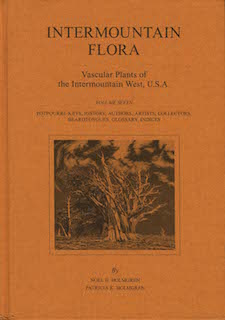Intermountain Flora, Vascular Plants of the Intermountain West, U.S.A. Volume Seven
Last Updated on November 21, 2022 by

by Noel H. Holmgren and Patricia K. Holmgren
ISBN 978-0-89327-456-4
New York Botanical Garden Press, New York, NY, 2017
How does one properly summarize, or as importantly celebrate, the culmination of nearly 50 years of research and documentation of one of North America’s major floristic regions? This question is beautifully answered in the final volume (7) of the Intermountain Flora, Vascular Plants of the Intermountain West, U.S.A. Encompassing, roughly, the area between the Sierra Nevada and Cascade Ranges in the west and the Rocky Mountains in the east, the Intermountain Flora (volumes 1-6) documents and describes all known, naturally occurring plant life within the region. The end cap of this massive work is volume 7.
Organizationally, Volume 7 Includes what the authors call a “potpourri” that includes keys to families represented in the flora, a history of the project with information on the authors, artists, and collectors in the intermountain west, an update of the 1984 treatment of the intermountain beardtongues (Penstemon), a glossary and a cumulative index to the seven volumes.
The first section of volume 7 lists the families contained in it and each of the previous volumes, followed by an alphabetical list of families and their corresponding volumes and page numbers. Following an acknowledgments section, the next major portion of the book is a key to all of the families represented in the entire Intermountain Flora. Having now used the key several times, I’m impressed with its user friendliness. The language is not overly technical, nor are obscure and difficult to discern characters used. I highly suggest that authors of upcoming floras use it as a model.
In the next section, an early history of the Intermountain Flora Project, I learned a flora for the intermountain west was first envisioned and planned, in 1931, by Bassett Maguire, a faculty member of Utah State Agricultural College (today Utah State University). The chapter details Maguire’s collaboration (beginning in 1943) with Arthur Holmgren, the former’s subsequent retirement from the project in 1956, and the collaboration, until 1968, between Holmgren and Arthur Cronquist, mainly involving fieldwork in preparation for writing.
The following chapter, humbly titled “Writing Intermountain Flora: When and Who” is, in my opinion, more than a simple historical or biographical narrative. Here, the reader is treated to stories penned by Noel Holmgren about his father (Arthur), Arthur Cronquist, Rupert Barneby, and James Reveal and his wife Patricia. These tales are, at various moments, funny, sad, thought-provoking, and always engrossing. I greatly appreciate Noel adding this very poignant, human touch—too often missing in chronicles of academic and scientific endeavors.
After engaging biographies of botanical artists Jeanne Janish and Bobbi Angell, I was very pleased to read a lengthy biography of the most prolific and, in my opinion, foremost botanist, living or dead, within the state of Nevada, Arnold (Jerry) Tiehm. Patricia Holmgren has written a thoroughly entertaining history of Jerry’s journey from one of eight children, to a college student avoiding the Vietnam War, later to a bellman and limo driver for casinos, and finally to his much-deserved position at the University of Nevada Natural History Museum.
The next chapter of the volume is easily my favorite, containing over 350 black and white and color photos of plant collectors of the intermountain west, dating from the 19th century to present day. Notable botanists range from historical (Asa Gray and Percy Train) to contemporary (Barbara Ertter and Richard Halse). These beautiful, glossy photos give us a glimpse of the hundreds of botanists, who through their hard work and dedication, made the Intermountain Flora (and other floristic works) possible. I heartily praise Noel and Patricia Holmgren for their compilation of this chapter.
The following chapter is an updated treatment of the genus Penstemon that was originally published in Volume 4. This genus is of great interest to Noel Holmgren and the focus of much of his scholarly research, thus the inclusion of this update in the final volume of the series. Noel highlights several other botanists, such as Elizabeth Neese, co-founder of the Utah Native Plant Society, whose research led to the taxonomic and nomenclatural changes in this genus. Students of Penstemon with undoubtedly find this chapter invaluable.
The remainder of the volume consists mainly of a comprehensive glossary, containing nearly 1500 entries, and a cumulative index to not only the people and plants found in Volume 7, but also all taxa found in Volumes 1-6. The latter is an extremely welcome addition for those of us who have been actively using the previously published volumes for many years.
Within the last section are four pages that might be easily overlooked. Academically titled “Nomenclatural Innovations, Typifications, and Chromosome Data,” the volume of work detailed in these few pages symbolically summarizes the monumental task involved in compiling the entire Intermountain Flora. With over 150 nomenclatural innovations (describing a taxon new to science, or changing the name or rank of an existing taxon) and nearly 50 typifications (designating a type specimen where one did not previously exist), clearly the assembly of these books has made a prodigious impact on not only plant taxonomy within the western United States and North America.
Whether you own all volumes of the Intermountain Flora, or are interested in purchasing your first, I highly recommend the addition of Volume 7 to your botanical library.
—Stephen C. Meyers, Oregon Flora Project.
